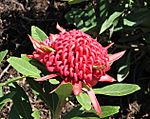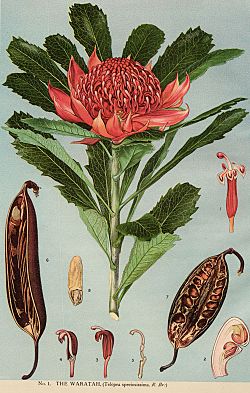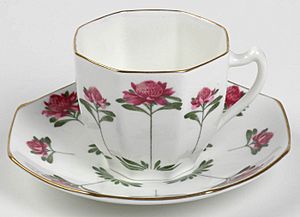Waratah facts for kids
Quick facts for kids Waratah |
|
|---|---|
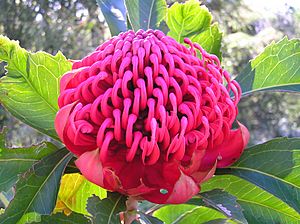 |
|
| Telopea speciosissima | |
| Scientific classification |
|
| Kingdom: | Plantae |
| Clade: | Tracheophytes |
| Clade: | Angiosperms |
| Clade: | Eudicots |
| Order: | Proteales |
| Family: | Proteaceae |
| Subfamily: | Grevilleoideae |
| Tribe: | Embothrieae |
| Subtribe: | Embothriinae |
| Genus: | Telopea (Sm.) R.Br. |
| Synonyms | |
|
|
The Waratah (Telopea) is a group of five types of large shrubs or small trees found only in Australia. They grow naturally in the southeastern parts of Australia, including New South Wales, Victoria, and Tasmania. The most famous type is the Telopea speciosissima, which has bright red flowers. It is even the special plant symbol for New South Wales!
Waratahs belong to a plant family called Proteaceae. This family of flowering plants grows in the southern half of the world. A special thing about Proteaceae plants is their flowers. They often have very large, bright, and showy flower heads. These heads are made up of many small flowers packed closely together. Waratah flower heads can be 6 to 15 centimeters wide. They also have a ring of colorful leaves called bracts at their base. The leaves of the Waratah are arranged in a spiral, are 10 to 20 centimeters long, and can have smooth or toothed edges. The name waratah comes from the Eora Aboriginal people, who were the first people to live in the Sydney area.
Contents
What is a Waratah?
The Telopea group of plants is part of the Proteaceae plant family. Their closest plant relatives are the Alloxylon (Tree Waratahs), Oreocallis, and Embothrium plants. These plants usually have red flowers and are found around the southern edges of the Pacific Ring of Fire. Together, they form a smaller group called Embothriinae.
The Telopea group was first described in 1810 by Robert Brown. He used the Telopea speciosissima as the main example. There are five types of plants within the Telopea group. They can easily mix and create new types when grown by people.
Types of Waratah Plants
The Waratah group has five different types of plants:
| Common and scientific names | Image | What it looks like | Where it grows |
|---|---|---|---|
| Gibraltar Range waratah or New England waratah (Telopea aspera) |
 |
This plant looks very much like the New South Wales waratah. It was named as a separate type in 1987. | Northeast New South Wales |
| Braidwood Waratah or Monga waratah (Telopea mongaensis) |
 |
This is a shrub with red flower heads. It is very similar to T. oreades. | Southeastern New South Wales |
| Gippsland waratah or Victorian waratah (Telopea oreades) |
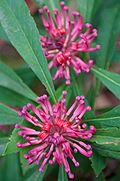 |
This is usually a tall shrub or small tree with red flower heads. It is very similar to T. mongaensis. | East Gippsland in Victoria and southern New South Wales |
| New South Wales waratah (Telopea speciosissima) |
 |
This is the most famous waratah. It has large, bright red flower heads. | East New South Wales |
| Tasmanian waratah (Telopea truncata) |
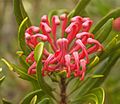 |
This is usually a shrub with red flower heads. | All over Tasmania, especially between 600-1200 meters high. It is also grown by people in Tasmania. |
Where Waratahs Live
Waratah plants grow as large shrubs or small trees. Their leaves are arranged in a spiral and can have smooth or toothed edges. They like sandy soil that drains water well. Waratahs are also special because they flower after fires. This helps them spread their seeds and grow well in the changed environment after a fire.
Where Waratahs are Found
The five types of Telopea plants naturally grow only along the east coast of Australia. This stretches from northern New South Wales down to Tasmania. Each type of Waratah has its own natural area where it grows, with little to no overlap. Changes in weather might have stopped them from spreading further or caused them to be isolated in certain areas.
However, Waratahs can also be grown in places outside their natural areas. Many are grown north of Sydney and in the Dandenong Ranges in Victoria. T. speciosissima has even grown well in other parts of Australia, like southwest Western Australia and the Queensland coast. Outside Australia, countries like New Zealand, the USA, South Africa, and Israel have also successfully grown Waratahs. It was brought to England in 1789 but usually cannot survive the cold English winters outdoors.
Growing Waratahs
For a long time, Waratahs were known as difficult plants to grow. They need specific conditions, and many people failed when trying to plant them. This can happen if the soil, sunlight, or climate is not right. Waratahs also grow slowly and have a short, unpredictable flowering time.
Because they were hard to grow, about 90% of all Waratahs sold in Sydney's markets in the early 1990s were picked from the wild. Over the past 20 years, some progress has been made. Several types of Waratahs are now grown by businesses, mostly near Sydney and in the Dandenong Ranges in Victoria. But growing them still has its challenges.
How to Grow New Waratah Plants
Growing new Waratah plants for sale is fairly easy compared to other parts of their growth. Plants are usually grown from cuttings, fresh seeds, or stored seeds. Fresh seeds sprout well but lose their ability to grow quickly unless kept cold and dry. Dry seeds can last a few years in cold storage. They should be treated with a special powder to prevent fungus before storing and planting.
The best time to take cuttings is when the plant is growing quickly. Cuttings are taken from strong wood that grew in the last year. If there isn't much plant material, even single leaf nodes can be used to grow new plants.
Other ways to grow Waratahs include grafting and tissue culture. These methods are successful but not widely used for large-scale growing. Grafting involves joining parts of two plants together. Tissue culture is a complex process where tiny pieces of a plant are grown in a lab.
For Waratah plants grown from seeds, it takes about 5 years for them to flower. Plants grown from cuttings might flower in just 2 years. Growing from seeds is the most common way. However, certain types of Waratahs must be grown from cuttings if you want the new plants to be exactly like the parent plant. Fresh seeds sprout well and usually grow in 2–3 weeks after planting.
Growing Waratahs for Sale
Growing Waratahs for sale is tricky because their flowering time, number of flowers, and quality are easily affected by changes in their environment. These things must be thought about even before buying land to grow them.
- Sunlight: A north-facing area gets the most sun. Having slopes facing north, east, and west can help spread out the flowering time. Western slopes will flower a little later. The closer to the equator, the earlier they will flower.
- Elevation: How high up the land is also matters, as it affects temperature, which greatly influences when flowers appear. More flowers will grow in full sunlight, but better quality flowers are found in the shade.
- Soil and Drainage: A very important thing for growing Waratahs is good water drainage. In nature, Waratahs grow in poor, sandy soils that drain water very well. This is why they thrive there. If the soil drains well, nutrients are quickly washed away. So, it's best to add fertilizer in small amounts at important growth stages.
- Watering: Waratahs are tough Australian native plants that can handle harsh environments and low rainfall. However, for growing them commercially, watering systems are still needed to get a reliable crop and good quality flowers.
- Pruning: Cutting back the plants (pruning) is very important for growing Waratahs for sale. The goal is to shape the plant so it produces the most flowers that can be sold. You want to get as many growing tips as possible, as this is where the flowers will grow.
With the right conditions, a single Waratah plant can produce up to sixty flowers each year. This could mean 20,000 to 50,000 flowers per hectare (about 2.5 acres). Waratah flowers are picked when 0–50% of the small flowers inside the head are open. Flowers with only 0–5% open last the longest after being cut.
Special Types of Waratahs
Many special types of T. speciosissima and mixes with other Telopea species are now being grown. These types have different colors of flowers or bracts. Some examples include:
- 'Fire 'n' Ice' – red flowers with white tips
- 'Songlines' – pink when in bud, opening to flame red
- 'Dreaming' – styles (parts of the flower) open white and turn pink
- 'Shade of Pale' – cream color with a hint of pink
- 'Brimstone Blush' – red with a pink blush
- 'Braidwood Brilliant' – red (a mix of T. speciosissima and T. mongaensis)
- 'Wirrimbirra White' – almost pure white
- 'Shady Lady' – blood red (a mix of T. speciosissima and T. oreades)
Problems When Growing Waratahs
Growing Waratahs can have problems at different stages.
- Seedling Problems: Young Waratah plants often get a condition called damping off. This causes seeds or young plants to die, often due to different types of fungi. The problem is often made worse by too much wetness.
- Bract Browning: A big problem for growers is when the colorful bracts (leaves around the flower head) turn brown before the flowers are picked. This makes the cut flowers less valuable. Browning usually happens from too much sun but can also be from wind. Using shade cloths can help reduce this problem.
- Weeds: In nature, Waratahs do not compete well with other plants. They grow best after a fire when other plants are removed. This means that weeds can greatly affect Waratah growth, especially when the Waratahs are small. Weeds should be controlled carefully when the plants are young.
- Pests: In New South Wales, the most harmful pest to Waratah crops is the macadamia twig girdler. Its larvae (young insects) cause damage, often starting at a branch fork or leaf. They can also burrow into the developing flower head, destroying the entire crop if not controlled. To control them, encouraging birds can help. Regular pest control sprays are also needed. Other smaller pests include white scale and Macadamia leafminer. Leafminers don't kill the plant, but they damage the leaves, which lowers the value of the flowers for sale.
- Fungal Infections: Fungi can cause stem rot and root rot, which can kill the plant. These problems can usually be controlled by making sure the soil drains well.
- Flower Differences: Another problem is that the flowers produced can look very different from each other because of natural genetic variation. The industry wants to improve the quality and consistency of the cut flowers. Having inconsistent products makes it harder for the industry to grow.
How Waratah Flowers Look and Grow
In many Proteaceae plants, the flower head is very large, showy, and often brightly colored. It is made up of many small flowers packed closely together. Telopea plants live a long time and can regrow from their base after a fire. After a few years, the regrowing stems produce flowers each year.
What we call a Waratah 'flower' is actually a flower head (inflorescence). This head can have anywhere from 10 to 240 individual small flowers, depending on the type of Waratah. The style (a part of the flower) has a special tip called a 'pollen-presenter'. This part holds the pollen for pollinators. When the flower opens, the stigma (another part of the flower) is first trapped. As the style grows, it bends until it breaks free and springs upright. A fully open flower head usually has both male and female flowers working at the same time. These flower heads range from 6 to 15 centimeters wide and have a ring of colorful bracts at their base.
How Waratahs Flower
Before a flower can grow, the plant needs to go through a process called floral induction and initiation. This means the plant's growing tips get ready to make flowers. It involves changes inside the plant, and these changes can be affected by things like plant hormones. Once this process starts, the plant will usually develop flowers, even if the original signal that started it is gone. Sometimes, flowering simply happens when a plant gets old enough. But for many plants, flowering happens because of environmental signals, or it might be stopped by them.
For T. speciosissima, flower growth starts around mid-December. Flower buds grow faster on older shoots, and tiny flower parts appear from mid-January to February. This happens over 6–8 weeks after the main growth spurt from November to January. After these tiny flower parts appear, the plant might have another period of leaf growth. The flower then develops inside a bud for seven to eight months. The exact date when the flowers open can change a lot because Waratah flowering is sensitive to its surroundings.
Flowering times tend to vary based on where the plant is located and the climate. They can flower as early as August in coastal Queensland and as late as December in Tasmania. Waratahs in one place have a short flowering period. However, different types can be chosen to make sure flowers are available over a longer time. Generally, Waratahs flower for 4–6 weeks in spring (September–October) in the Sydney area, but later in cooler places.
See also
 In Spanish: Waratah para niños
In Spanish: Waratah para niños



